Strategy: Defining and Teaching Classroom Rules and Routines
Teaching students classroom rules and daily routines will help them be successful and can minimize disruptions in the classroom. The beginning of class, in between lessons, and the end of the school day are all critical times when having clear rules and routines can help maximize instruction time. Teaching classroom rules and routines as early in the school year as possible will allow students to learn expectations and the flow of the classroom. Once rules and routines are learned, students should be able to transition throughout the day with minimal lost time.
Classroom rules are constructed from pre-defined behavioral expectations—either schoolwide or classroom-wide. While expectations are global qualities you expect students and staff to maintain, rules are concrete and observable actions. Schoolwide expectations and classroom rules are often used in conjunction with one another. Examples of these two working in alignment can include the following:
Behavioral Expectation
Classroom Rule
Classroom Event
Routine
Using the restroom
- Raise your hand and ask to use the restroom during a natural break in the lesson
- Sign out on the bathroom log when you leave and sign back in on the log when you return
Coming in from recess
- Grab the materials listed on the board from your backpack
- Go to your seat and sit quietly while waiting for instruction
Effective communication is a core component of defining and teaching rules and routines. Effectively communicating rules and routines for all students promotes equity in the classroom and decreases instances of disruptive behavior, which can escalate to result in racial disproportionality in disciplinary practices. When all students know what is expected of them, following rules and routines can become second nature, providing more learning time.
Culturally responsive teachers hold high expectations for the behaviors of all students and they allow students to help generate rules or engage in discussions about pre-determined classroom rules. Rules are enforced consistently and equitably for all students. Furthermore, if students seem to be having difficulty following the rules and routines put into place, it might be time to revisit how they are taught and explained to the class. Opening up a discussion for students about the effectiveness or lack thereof with the rules and routines can help you to navigate more effective ways to communicate your expectations to all of your students.
How to Teach Classroom Rules and Routines
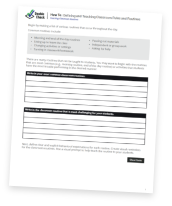
| Define Rule or Routine |
| Keep your hands and feet to yourself. (rule) Entering the classroom. (routine) |
| Teach |
| Provide a verbal description of the rule and its relevance: “We keep our hands and feet to ourselves because it is respectful and keeps us safe.” “We enter the classroom by quietly hanging up our bookbag, walking to our seat, and getting started on the warm-up right away.” |
| Model |
| Provide a positive example: “When we sit at circle time, this is what our bodies should look like.” (Demonstrate sitting cross-legged with hands in lap.)
*It is important that only adults model non-examples. We only want students to practice the positive example of the behavior. |
| Practice |
Ask for a student to volunteer to demonstrate the rule or routine: If possible, allow the entire class to demonstrate the rule: If possible, allow the entire class to demonstrate the routine: |
| Praise/Reinforce |
| Provide specific praise to students for appropriate demonstration of the rule or routine. Devise a plan for reinforcement of rule-following: “Each morning, I will be looking for students who are entering the classroom by quickly hanging up their bookbag, walking to their seat, and immediately getting started on the daily warm-up task.” |
Posting Classroom Rules and Routines
- Rules should be concise and positively stated
- Keep each step of the routine as concise as possible.
- Ensure that the steps are developmentally appropriate. Using pictures and large print is a great way to communicate classroom expectations for young children who may not be able to read the labels.
- Try to keep routines to as few steps as possible.
Examples of Classroom Routines
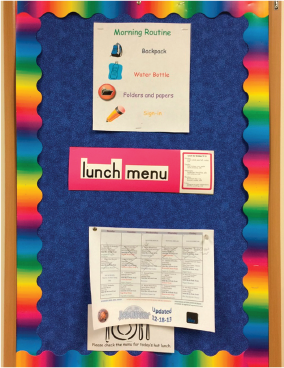
Example of Posted Morning Routine with Images
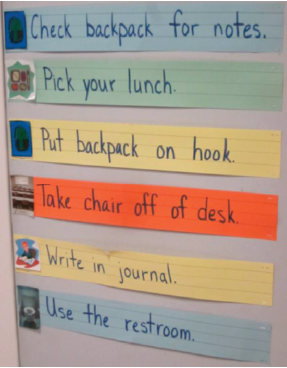
Morning Routine with Images and Words
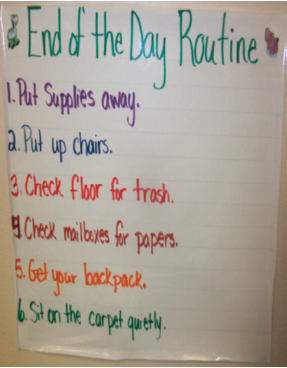
End of the Day Routine

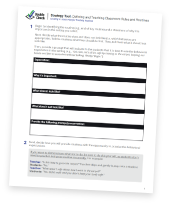
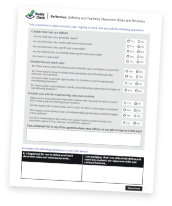
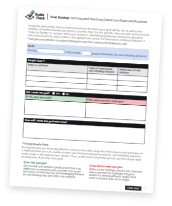
References to Other Relevant Resources:
Sprick, R. (2009). CHAMPS: A proactive and positive approach to classroom management. Eugene, OR: Pacific Northwest Publishing.
Reinke, W., Herman, K., & Sprick, R. (2011). Motivational interviewing for effective classroom management: The classroom check-up. New York, NY: The Guilford Press.
Teaching Tolerance. (2016). Critical practices for anti-bias education. Retrieved from: https://www.tolerance.org/sites/default/files/2017-06/PDA%20Critical%20Practices_0.pdf